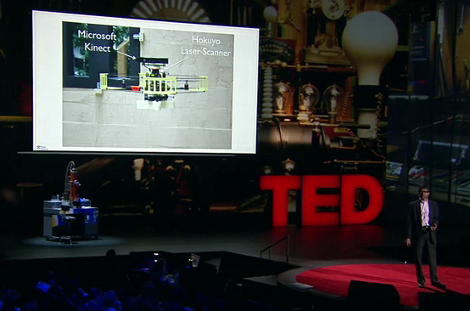
[Vijay Kumar] is a professor at the University of Pennsylvania and the director of the GRASP lab where research centering around autonomous quadcopters is being met with great success. If you were intrigued by the video demonstrations seen over the last few years, you won’t want to miss the TED talk [Dr. Kumar] recently gave on the program’s research. We touched on this the other week when we featured a swarm of the robots in a music video, but there’s a lot more to be learned about what this type of swarm coordination means moving forward.
We’re always wondering where this technology will go since all of the experiments we’ve seen depend on an array of high-speed cameras to give positional feedback to each bot in the swarm. The image above is a screenshot taken about twelve minutes into the TED talk video (embedded after the break). Here [Dr. Kumar] addresses the issue of moving beyond those cameras. The quadcopter shown on the projection screen is one possible solution. It carries a Kinect depth camera and laser rangefinder. This is a mapping robot that is designed to enter an unknown structure and create a 3D model of the environment.
The benefits of this information are obvious, but this raises one other possibility in our minds. Since the robots are designed to function as an autonomous swarm, could they all be outfitted with cameras, and make up the positional-feedback grid for one another? Let us know what you think about it in the comments section.
[youtube=http://www.youtube.com/watch?v=4ErEBkj_3PY&w=470]
[Thanks László]















well, while i admit i don’t know much about quadcopters, would a super low strength magnetic field array work? i heard about something like that used before in the razer hydra pc motion controller, where the base tracks the hand sticks by such a method. not sure how it could be implemented, but to toss an idea out, a swarm of copters with designated locators to get the area information and act as directors for the rest in the swarm, all of them knowing where each other is by that field array. just a thought
beware the swarm! love this
Sharpen the blades, make a few hundred of these and try on a swarm of locusts …
i hate to say… almost old news at this point.
agreed, i even heard it on mainstream dutch radio about a week back, after seeing it appear on numerous websites.
And about the swarm network, they are all controlled by an external computer so if it can handle the connections and proccessing power…. no problem.
Skynet has to start somewhere, somehow.
+1
The unknown building mapping was amazing. So many military applications.
I wonder what the unit cost is and how long the batteries last. All the components crammed onto a PCB must make them fairly cheap.
pure entertainment!
Tango Echo Delta please translate.
Technology, Entertainment, Design.
Didn’t know that the first and second derivatives of acceleration were called jerk and snap.
Too bad you didn’t know that during highschool physics class. Trolling the teacher about jerks per second never got old.
Christ, just be careful to avoid the snap.
the sound of the quadrocoptors is kinda eerie…like you just know they are the sound which will send humans fleeing in the near future.
1. This is not a hack.
2. Anything that comes from TED is a waste of time.
Adding a Kinect to an off the shelf quadcopter isn’t a hack?
Seriously?
Does it have any non-sinister applications? Obviously the US military, in particular, are happy to throw money at any old nonsense (MK ULTRA and training men to kill goats with their minds), which helps the research. But do we really need to make it any easier for oil companies to oust troublesome world leaders, under the gigantically broad cover of “fighting terrorism”?
Is there anything nice it can do? Anything that doesn’t make it cheaper, easier, and more media-friendly to kill people?
I can see these maybe being handy mobile servants in the house of the future, but before then, the AI needs sorting out. It seems a shame for smart people to aid horrible people in their endeavours, just because it’s k3wl. Obviously quadcopters ARE k3wl, but still.
Stupid government spending money on research that results in things like the internet, modern prosthetics, all modern wireless devices, GPS, space exploration and pretty much all satellite technology, speech translation software, high-level programming languages and the entire concept of interrupt based operating system environments, modern and future LED lighting, how we obtain and process our water and waste, etc, etc.
Seriously though, I can think of at least four dozen different applications for this kind of technology in the civil sector.
For all you folks who are getting all “ZOMG SKYNET” I have two words:
Silly. String.
rm -rf /users/hexmonkey
Skynet is almost here…….